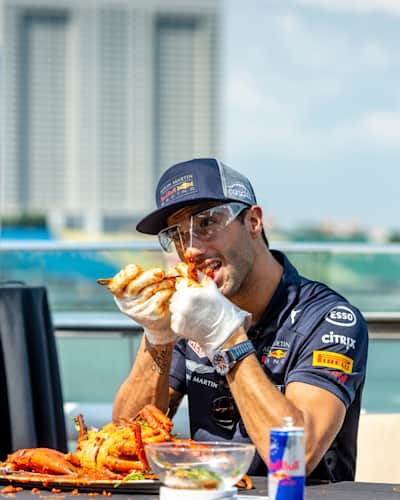Red Bull Motorsports

F1
What does an F1 driver eat in a day?
To reach the top table of motorsport, you need supreme driving skills, incredible fitness, zen-like concentration and watch what’s on your dining table. So what is on the menu for F1 drivers?
The modern F1 driver is a combination of many talents – in addition to being able to drive, they need to give accurate feedback to the team on the pit wall, understand the car set-up and have the business acumen to manage their career. They also need to be supremely fit.
Diet plays a huge role in staying in shape and on top of their game, so it’s essential to know what fuel to put in the tank. Here’s our guide to nutrition for F1 drivers.
01
Why an F1 driver’s diet is so important
Racing an F1 car is exhausting: in the most extreme race, the Singapore Grand Prix where it’s twice as hot as any other race, the driver will lose 3-4kg in sweat. And in any Grand Prix, the drivers’ bodies are working overtime to cope with the heat and G force stress. It’s also mentally grueling finding the perfect racing line, attacking, defending and communicating with the pit wall. A meal plan therefore is based on building strength and focus.
What's on the menu
Carbohydrates: The drivers are going to need their energy so they are loading on carbs both before a race and before training. That’s going to come in the form of slow-burning, high-fiber carbs from grains, brown rice and pulses rather than pasta or french fries. Those carbs are also rich in potassium and magnesium to help the mind, muscles and nervous system to perform.
Daniel Riccardo and Max Verstappen (2018): Having a balanced diet is key.
© Chee Boon Pin/Red Bull Content Pool
Fruit and vegetables: Low in fat and high in energy, vitamins and minerals, the drivers have almost unlimited access to the salad bar where they can load up on vegetables and fresh fruit. They need at least five to seven servings of fruit and veg a day but more is advised. As well as the obvious nutritional value, these will help with energy release and boost their immunity.
Protein: As any gym bro will tell you, protein provides amino acids that are essential for building muscle tissue. It is also essential for healing injuries such as strains and bruises. It takes two grams of protein to every kilo of body weight to maintain body mass, which means drivers need a high protein diet, ideally low in fat like chicken and fish while tofu and pulses are perfect for vegans like seven-time World Champion Lewis Hamilton.
Water: Staying hydrated is essential and drivers are never far from their drinks bottle. Eagle-eyed F1 fans will also have noticed drivers drinking from wearable pouches – these are packed with electrolytes that they will sweat out in the race. These help maintain blood glucose levels to manage mental and physical fatigue. Red Bull drivers also have a ready supply of caffeine and sugar at hand in the form of a functional energy drink.
02
What would an F1 driver eat on a typical day?
Here’s what’s on the menu for a day on a race weekend.
- Breakfast: Porridge with berries, banana, nuts, sweetened with honey.
- Lunch: Salad, followed by chicken breast, tomato salsa and boiled vegetables. Fruit for dessert.
- Dinner: Tomato soup followed by grilled fish, sweet potato and salad. Yogurt for dessert.
03
What’s the ideal weight, height and shape for an F1 driver?
Daniel Ricciardo in a food truck: F1 drivers have to watch what they eat
© Mark Thompson/Getty Images/Red Bull Content Pool
The lighter the car, the less power needed to propel it around the track, the less it wears down key components such as tires and the faster and/or longer it can run. When it comes to drivers, they are shaped by the era they race in. Compare Keke Rosberg with his son Nico: two F1 World Champions but very different body frames. In the early 80s, Keke was racing turbo-charged cars with steel engines and metal chassis – he needed a lot of upper-body strength to wrestle the heavyweight machine.
The cars Nico raced 25 years later were a very different beast as ultra-light materials brought the weight car down and drivers also needed to be light. With some drivers starving themselves to achieve their fighting weight, in 2019, a minimum combined weight was introduced: 180kg including driver, helmet, boots and race suit.
For the record, in 2024, the three-time World Champion Max Verstappen is the tallest driver in the Red Bull stable at 180cm tall and weighing 71kg, followed by Daniel Ricciardo 178cm/70kg, Sergio Pérez 175cm/63kg and Yuki Tsunoda 159cm/53kg. Since you asked, the tallest driver on the grid is Alex Albon 186cm/76kg.
04
What about comfort food?
Some days you just need a cheeseburger. Or, in the case of '60s racer Pedro Rodríguez, the Mexican who was based in the UK always carried a bottle of Tabasco sauce to spice up the bland food.
For Verstappen, a humble bowl of tomato soup is enough as it was his childhood favorite.
Meanwhile, Tsunoda is a true foodie. When he hangs up his racing gloves, he plans to open his own fusion restaurant combining Japanese cuisine with foods he’s enjoyed as he’s travelled the world with the F1 circus.
It helps that he lives in the gourmet paradise of Italy. "I like how they are passionate about food in Italy," he told ESPN. "I like their starters, and obviously pasta and pizza with something on it.”
And that puts it in perspective: the career of an F1 driver is short and diet is just another component to get right on the road to the top. Former Faenza team boss Franz Tost, who mentored the careers of race winners like Sebastian Vettel, Max Verstappen, Daniel Ricciardo and Carlos Sainz, put it this way: “Nutrition is a part of discipline. It’s extremely important. I don’t care how good mortadella tastes, it has no place on my drivers’ plates.”








